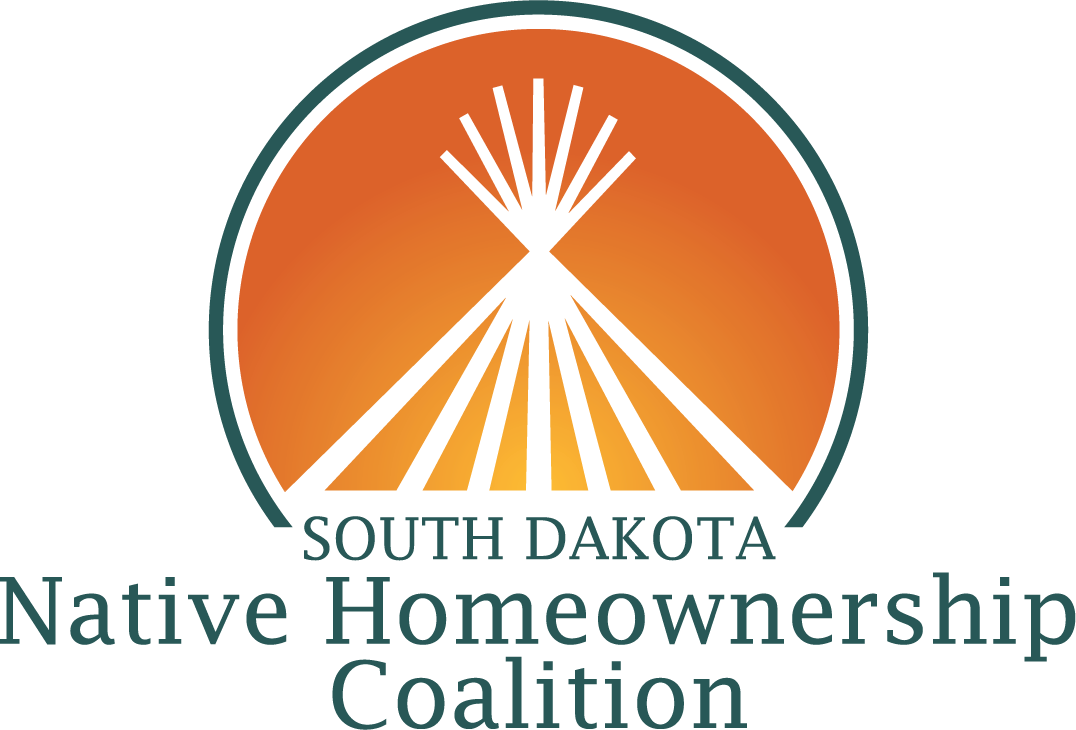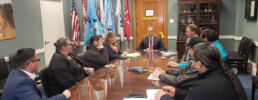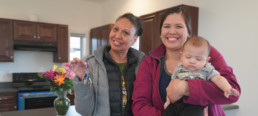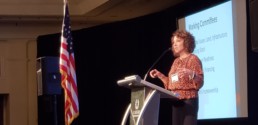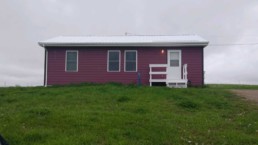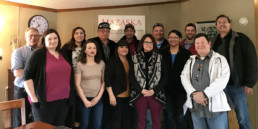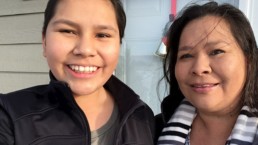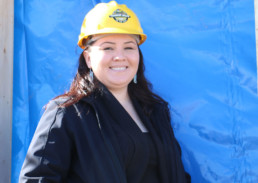Coalition Members Discuss Native American Homeownership on Freddie Mac Podcast
During the Freddie Mac Home Starts Here podcast, James Cromartie from Freddie Mac (a Tiospaye Member) and Tawney Brunsch (Executive Committee member) discuss the realities of homeownership. They outline, not only the challenges, but also the exciting headway that is being made to increase homeownership opportunities in Native communities.
South Dakota Congressional Delegation Urges USDA to Continue Home Loan Program on Tribal Land
Three members of the United States Congress – Senator John Thune (R-SD), Senator Michael Rounds (R-SD), and Representative Dusty Johnson (D-SD) – urged U.S. Department of Agriculture (USDA) Secretary Sonny Perdue to allocate additional funding to continue the 502 Relending Home Loan Program on tribal land in South Dakota.
Through this program, USDA Rural Development collaborated with two Native community development financial institutions (CDFIs) to increase access to Section 502 Direct Home Loans in Indian Country. The program was highly successful, deploying nearly $2 million in mortgage loans on two South Dakota Indian reservations in less than a year – about three times the amount deployed in the previous decade. The two Native CDFIs participating in the program – Four Bands Community Fund on the Cheyenne River Reservation and Mazaska Owecaso Otipi Financial on the Pine Ridge Reservation – estimate a growing pipeline of more than $3 million for Section 502 Direct Home Loans.
“As demand for homeownership strengthens amid the COVID-19 pandemic, the continuation of the pilot program would help more tribal families escape overcrowded housing situations and achieve their goals of homeownership,” said Sharon Vogel, executive director of the Cheyenne River Housing Authority and co-chair of the South Dakota Native Homeownership Coalition’s policy committee.
“We really appreciate Senator Thune’s leadership and the ongoing support from our South Dakota congressional delegation,” added J.C. Crawford, Chief Executive Manager of CBJ Producers, LLC and co-chair of the Coalition’s policy committee. “They understand that through this partnership with USDA, Native CDFIs are in the best place to get affordable 502 mortgage capital into tribal communities. Lakota Vogel at Four Bands, Colleen Steele at Mazaska and their lending teams are doing great work on the frontlines assisting their clients to navigate the homeownership process on trust land.”
A copy of the letter from the South Dakota congressional delegation can be viewed here:
Debra Phelps Becomes 5th Homeowner in Thunder Valley Regenerative Community
Although many things came to a halt with the onset of the COVID-19 pandemic, some aspects of life carried on. After nearly a year of hard work and dedication, Debra Phelps, a Sisseton Wahpeton Oyate tribal member and a Marine Corps veteran, became a first-time homeowner at the end of March, when she purchased a 3-bedroom, 1 ½ bath home in the Thunder Valley Regenerative Community on the Pine Ridge Reservation in South Dakota.
Although she hadn’t thought of it yet, Debra began preparing for homeownership a year before she actually began the mortgage process. As an employee of Thunder Valley Community Development Corporation (TVCDC), she was required to complete financial literacy classes.
“I’m up there in age, so I thought I knew everything about financials. I’m glad we had to do it, though. It makes you think about things you hadn’t before,” says Debra.
That was a turning point for her. She took some steps to increase her credit score, and also started talking to her three grown children about credit. Most importantly, she began transforming her financial habits.
“I started paying attention to my spending and asking myself at the cash register if this was a need or a want,” she explains.
As time went on, Debra began thinking about aging and her future. “I didn’t want to put the burden on my kids, so that is how I started thinking about homeownership.”
Debra began working with her colleagues, Ana Garibaldi and Star Means who are part of the Housing and Homeownership Initiative at TVCDC, to become mortgage-ready, figure out the best-fit loan product, and identify potential subsidies. Ana and Star are also active participants on the South Dakota Native Homeownership Coalition’s Homebuyer Readiness Committee and Native Veterans Homeownership Committee. Debra says the most challenging thing along the way was the paperwork.
“There is a lot to know – what you are reading, what it really means. It is a scary process if you don’t know what you are doing, but Ana and Star were there to help me through it,” says Debra.
TVCDC leveraged partnerships with Oglala Sioux Lakota Housing and the South Dakota Housing Development Authority to help Debra secure over $50,000 in subsidies to offset loan processing fees and construction costs. Ana from TVCDC explains that the subsidies are a critical piece to making homeownership possible for many people, especially because construction costs in a rural area average about 20% higher than in urban areas.
“We really appreciate our partners, because the subsidies are key to making homeownership affordable on the Pine Ridge Reservation. They help keep monthly mortgage, property tax, and insurance payments within a reasonable range for our homeowners,” says Ana.
Debra says the most rewarding part of her homeownership journey was getting approved for her VA Home Loan, which was through First National Bank in Rapid City.
“I always wanted to own my own home, but I never thought I would or could. Just being able to qualify was good,” she says.
Debra loves her new home, especially the high ceilings on the first floor, natural light, and mud room that is really great for her two dogs. She is still getting used to the idea of being a homeowner, though.
“Sometimes when I turn on the TV, I worry about being too loud. I’ve lived in apartments my whole life, and I forget that I’m in my own home and I can be as loud as I want,” she laughs.
Debra looks forward to helping her children become homeowners when they are ready. In the meantime, she continues to provide guidance on credit and spending.
“This was another thing I was able to experience before them, so I can help them with it when they go through it,” she says.
Pilot Program Increases Rates of Mortgage Lending on South Dakota’s Reservations
During her address at the National American Indian Housing Council’s Legal Symposium, Tawney Brunsch, Executive Committee Member of the South Dakota Native Homeownership Coalition, reported that through a partnership with USDA Rural Development, two Native community development financial institutions (CDFIs) deployed eight home loans totaling nearly $1 million in two reservation communities during the past couple of months – more than was deployed in the previous nine years prior to the start of the program.
USDA Rural Development officially launched the 502 Direct Native CDFI Relending Pilot Program last summer as a way to increase homeownership opportunities on tribal lands, and approval of funds for deployment began in October this year.
“The 502 Relending Pilot has been a huge success! USDA, the South Dakota Native Homeownership Coalition, and the Native CDFIs have worked together to efficiently expand access to affordable mortgage capital to Native borrowers on trust land,” said Brunsch.
In just two months, the two Native CDFIs participating in the pilot, Four Bands Community Fund on the Cheyenne River Reservation and Mazaska Owecaso Otipi Financial on the Pine Ridge Reservation, have deployed approximately 50% of the $2 million in loan capital that was allocated to the pilot program and are currently working with 24 more families who are applying for the USDA 502 Direct Loan.
“This deployment rate shows that Native CDFIs are able to leverage their strong relationships within the communities they serve and their expertise in mortgage lending processes on tribal trust lands to accelerate homeownership rates on Indian reservations,” explains Brunsch.
The South Dakota Native Homeownership Coalition began advocating for the pilot program in 2015 and worked closely with U.S. Senator John Thune (R-SD), U.S. Senator Mike Rounds (R-SD), and U.S. Senator John Hoeven (R-ND). In March 2018, the South Dakota congressional delegation requested that USDA implement the pilot and recognized that while the 502 Direct Loan program was highly utilized, only 23 of the 7,187 loans made through the program in fiscal year 2017 went to Native American families on tribal lands.
Brunsch says the South Dakota Native Homeownership Coalition’s next step will be continued advocacy with the intention of making the pilot permanent so that it can be expanded to other Native communities throughout the country.
“We appreciate the leadership of our Senators who made this pilot possible and are excited to partner with the National American Indian Housing Council, National Congress of American Indians, and the Native CDFI Network to support the replication of this successful model in all Native communities,” Brunsch said.
Eighth Renter Transitions to Homeowner in Eagle Nest Housing Development
In the midst of an extreme housing shortage, it is estimated that the Pine Ridge Reservation needs an additional 4,000 homes to provide adequate housing for residents. With a virtually nonexistent residential real estate market, families are commonly on the waiting list for low-income tribal housing for two-plus years. In the meantime, they are “doubling up” or even “tripling up” – terms used to describe multiple families living in a single-family residence – so that their basic needs for shelter are met. As a situation that has spanned several generations, this has become a way of life on the Reservation.
“A lot of people don’t know anything about homeownership or mortgages. We hear about homeowners in the city, but not here,” explains Carrie Sitting Up who rented a home in the Eagle Nest Housing Development, located in the northeast corner of the Reservation.
However, that is beginning to change. As the first Native American Low-Income Housing Tax Credit (LIHTC) project in the country, Eagle Nest has provided affordable rental housing through its 30 single-family units since 1999. When the tax credit agreements reached maturity a few years ago, Lakota Funds, a nonprofit organization who developed the housing track and also a member of the Coalition, began converting the rental units into privately-owned homes.
Since then, they have been working with tenants to prepare them for homeownership by providing financial coaching, homebuyer readiness training, and other resources. During the Coalition’s 2017 Tour & Convening, we visited Eagle Nest and saw first-hand the progress they were making. The first sale in Eagle Nest closed in late 2017, and to date eight homes have sold!
Seeing another tenant become a homeowner inspired Sitting Up. She says, “I liked the outcome of her home. I didn’t think it was possible until I talked to her about it, and it gave me some motivation.”
Sitting Up’s homeownership journey began with getting her finances in order. She says this took some time, because she needed to clear up some debt. But, she was able to utilize Lakota Fund’s Credit Builder Loan to help her with this step.
“It was a beautiful experience, because I was able to figure out my finances on my own and take care of myself,” says Sitting Up.
She was moving through the loan application process with Mazaska Owecaso Otipi Financial, a community loan fund in Pine Ridge and also a Coalition member, when her father passed away in September 2018. After a time of grieving, she says she gathered herself together and sealed the deal.
She reflects on her loan signing, “I really cried, because my dad would have been so proud of me.”
As the first in her family to become a homeowner, Sitting Up says, “I feel like I won a grand prize buying this home.”
Sitting Up rolled several improvements – new windows, doors, siding, and roof – into the purchase of her home. There were other minor repairs, but she wanted to fix those on her own so she could experience the real meaning of homeownership. That is a decision that also kept her mortgage payment, which is comparable to her rental payment, more affordable.
“I’m still learning. Owning a home is a big deal, and I have experienced a bit of a struggle. But I knew I had to do it, because it was important to me,” says Sitting Up. Although it wasn’t easy, she says homeownership has given her structure in her life and it has been a positive step.
Sitting Up is planning a house warming party to celebrate her one-year anniversary of homeownership this Fall. She hopes her story will inspire other people to achieve homeownership.
“I love my home, and I’m really happy living here,” she says.
Coalition Advocates for Native Homeownership in Washington DC
During the National American Indian Housing Council’s 2018 Legislative Conference, March 5-7 in Washington, DC, the South Dakota Native Homeownership Coalition mobilized a group of advocates that engaged in dialogue with numerous congressional representatives and federal agencies. This year’s group of advocates demonstrated a diverse representation of reservation communities, and included Tribally Designated Housing Entities, Tribal Veterans Service Officers, and partners from Cheyenne River, Lower Brule, Rosebud, Sisseton, Standing Rock, and Yankton.
During the DC trip, we met with Tara Sweeney, Assistant Secretary – Indian Affairs Department of the Interior to discuss the Bureau of Indian Affairs residential lease, mortgage, and Title Status Report approval processes. We urged the Assistant Secretary to streamline these processes, especially the Land Title Records Offices, which are not designed to accommodate the pace of the residential real estate market.
Other highlights included:
Providing updates on the USDA 502 Relending Pilot, and advocating to make it a permanent program for Native communities nationwide. We shared progress on the 502 Relending Pilot, currently being implemented in South Dakota by Four Bands Community Fund and Mazaska Owecaso Otipi Financial, with USDA Rural Development, as well as staff from Senator Mike Rounds (R-SD), Senator John Thune (R-SD), and Senator John Hoeven (R-ND), who were all instrumental in launching the pilot. Senator Hoeven even mentioned the 502 Relending Program in his address to the NAIHC Legislative Conference.
Meeting with the US Department of Veterans Affairs to discuss ways to streamline the Native American Direct Loan process in order to expand homeownership opportunities for Native American veterans on trust land. We proposed several policy recommendations that would expand outreach and assistance to Native veterans, design a loan packaging program, and pilot a relending demonstration, similar to the 502 Relending Pilot. We also advocated for these policies in our meeting with Senator Rounds’ Senate Committee on Veterans Affairs staff.
Sharing opportunities and challenges associated with Native homeownership with HUD Office of Native American Programs.We met with Deputy Assistant Secretary Heidi Frechette to advocate for solutions that would streamline processes and increase homeownership opportunities for Native Americans. Specifically, we discussed improving the implementation of HUD VASH vouchers, issues with the HUD Section 184 Indian Home Loan program, and BIA issues.
Meeting with Administration for Native Americans (ANA) Commissioner Jeannie Hovland and her staff to learning about how ANA’s programs could benefit the members of the Coalition.
Coalition Celebrates USDA 502 Relending Pilot
The US Department of Agriculture’s Assistant to the Secretary for Rural Development, Anne Hazlett visited the Pine Ridge Reservation to meet with Four Bands Community Fund, Mazaska Owecaso Otipi Financial, and other regional partners to discuss the launch of a pilot program to increase homeownership opportunities on tribal lands. Through the 502 Relending Pilot, USDA Rural Development is partnering with Four Bands and Mazaska, both Native community development financial institutions and active Coalition members, to deploy a total of $2,000,000 to eligible Native American homebuyers located in tribal communities of South Dakota and North Dakota. According to USDA, the CDFIs’ deep ties in local communities will help them to reach homebuyers more effectively than other lenders.
The Coalition is excited to see this new development and has been actively advocating for this model as a solution to increase access to USDA’s home loan programs for Native American families. Our efforts, led by our Policy Committee Co-chairpersons, JC Crawford and Sharon Vogel, have included engaging partners and policy makers in various meetings and briefings over the past four-plus years. By creating alliances and identifying champions, we continued to raise awareness of challenges and opportunities related to homeownership and Native American communities.
We’d like to express our gratitude especially to U.S. Senator John Thune (R-SD), as well as U.S. Senator Mike Rounds (R-SD) and U.S. Representative Kristi Noem (R-SD). The South Dakota delegation requested that USDA implement the pilot and recognized that while the 502 Direct Loan program is highly utilized, only 23 of the 7,187 loans made through the program in fiscal year 2017 went to Native American families on tribal lands. We’d also like to recognize U.S. Senators John Hoeven (D-ND) and Heidi Heitkamp (D-ND) who were instrumental in launching the pilot.
The Coalition will continue working with these legislators and USDA Rural Development as the pilot experiences great success. We anticipate that the 502 Relending Program will expand throughout Indian Country and hope it will be a model for creating greater access to other federal mortgage programs on tribal lands.
Thanks to the US Department of Agriculture for contributing photos of Ms. Hazlett’s visit!
Coalition Members Develop Innovative Approach to Increase Native Veteran Homeownership
Two Coalition members, Mazaska Owecaso Otipi Financial (Mazaska) and Lakota Funds, have teamed up to increase homeownership rates for Native American veterans through an innovative new approach that simplifies the path to homeownership. In late February, both organizations were present to support George O’Rourke and Darrel Hernandez as they closed their VA Native American Direct Loans (NADL) and took the final steps toward homeownership on the Pine Ridge Reservation.
Colleen Steele, Executive Director of Mazaska, explains the new approach was born out of listening sessions that were hosted by the Coalition. Through the listening sessions, she heard the stories of several Native American veterans and gained a solid understanding of the barriers they face in achieving homeownership.
“Some of the veterans we talked to had been trying to access mortgage products designed specifically for veterans for more than two years, and we realized that Mazaska could make things a lot easier for them,” says Steele.
Through the new model, Mazaska provides a construction loan to the veteran and then helps them refinance with the Veterans Affairs Native American Direct Loan once the home is constructed. Mazaska also provides homebuyer education and assistance throughout the loan process. Especially during the complex refinance, Mazaska and Lakota Funds work together to provide intensive support to the homebuyer and coordinate with the U.S. Department of Veterans Affairs to keep things moving forward.
George O’Rourke comments on his experience, “The Mazaska program helped make refinancing my home with the Native American Direct Loan a simple quick process. I would like to thank Veterans Affairs for working with Mazaska to create this opportunity for future veterans.”
“It was a long time coming,” says Darrell Hernandez. “I really appreciate the help I received from Mazaska to get the loan finalized so that my family could move into our new home. I am more committed than ever to work with the U.S. Department of Veterans Affairs to streamline the Native American Direct Loan process so that other Native veterans won’t have to wait so long.”
“Our Native American veterans have sacrificed a lot by serving our country. We are glad to serve them as they pursue their homeownership dreams,” says Steele.
Family Celebrates Homeownership this Holiday Season
During the Coalition’s annual site visit this past summer, we learned about the Eagle Nest Housing Development on the Pine Ridge Reservation and how some of our stakeholders were creating homeownership opportunities there. We are pleased to share this story about the first family in the development that has transitioned from renting to homeownership.
This holiday season, Cynthia Plenty Bull and her daughter will be celebrating in the same house they have lived in for the past six years. But this year, they will call the home their own. Cynthia is the first tenant in the 30-unit Eagle Nest Housing Development, originally built in 1997 as low-income rental housing, to make the move to homeownership.
For Cynthia, owning her own home means stability. This is especially critical on the Pine Ridge Reservation, an area with an extreme housing shortage where it is estimated that an additional 4,000 homes are needed to provide adequate housing for residents.
“When you are a homeowner, you don’t have to wonder when it will end or if your lease is going to increase and you won’t be able to afford it anymore,” Cynthia says.
When it was constructed, Eagle Nest Housing Development made history as the first Native American low-income housing tax credit development in America, and since then has provided families with affordable housing. The project was designed as a rent-to-own development, where families would have the option to purchase their homes. As the tax credit agreements have reached maturity, Lakota Funds, who owns the development and also an active Coalition member, is reaching out to current tenants and supporting those interested in transitioning from renting to homeownership.
“Although Lakota Funds has invested a lot into Eagle Nest over the last 19 years, our goal was never to turn a profit. It has always been about creating homeownership opportunities, and our board approved a sale price of the homes to make it affordable for the families in the area,” says Tawney Brunsch, the Executive Director of Lakota Funds.
Cynthia began her homeownership journey this summer by contacting Lakota Funds. Lakota Funds then referred Cynthia to Mazaska Owecaso Otipi Financial, a nonprofit loan fund that provides home loan products and also a Coalition member.
Cynthia comments, “They [Mazaska] would tell me step-by-step what to do. We sat down and they talked to us through the whole process. It wasn’t a scary thing.”
Working between the two partner organizations and her bank over the next five months, Cynthia was connected to all of the resources and capital she needed to reach her homeownership goals. Mazaska and Lakota Funds helped her with financial projections and budgeting to ensure the home purchase would be affordable. She worked with her bank to consolidate debt and lower monthly credit card payments. Cynthia also completed Mazaska’s homebuyer readiness course so she would know what to expect as a homeowner.
The nonprofits helped her identify a local contractor to plan out and estimate several renovations that she would roll into her mortgage loan. Mazaska was also instrumental in helping her access all of the subsidies she qualified for to offset down payment and closing costs, and make the home purchase more affordable. In addition, Mazaska provided the mortgage for Cynthia’s home purchase.
Cynthia closed her loan in October with zero down payment and closing costs, and her monthly payment on her 20-year mortgage is about the same as her rent payments were. Overall, she couldn’t have asked for a smoother transition from renting to owning. Cynthia now owns a 3-bedroom, 2-bathroom home with a new roof and windows, remodeled bathrooms, new flooring and paint, and many more upgrades.
She says that what she likes best about her new home is, “Everything is brand new to me, and everything is the way I like I it.”
Cynthia explains that her daughter, Tia, was instrumental in the renovations. They chose all of the materials together, and Tia provided input and some great ideas throughout the process.
“It was a really good experience for Tia, because when she grows up and wants to purchase another house she will know the steps,” says Cynthia.
In the meantime, Lakota Funds and Mazaska are helping more Eagle Nest families through the same home buying process. They anticipate that one more home loan will close by the end of the year and more will close in early 2018.
“It’s really exciting to see the momentum that Cynthia’s home purchase is creating. Now more families are inspired to go for homeownership,” says Tawney.
Traveling a Path to Self-Sufficiency
January Mathis Works Toward Homeownership
After a nearly five-year journey, January Mathis, a member of the Oglala Sioux Tribe, will soon be moving into a home she can call her own. January’s home is currently one of seven under construction in Thunder Valley Community Development Corporation’s regenerative community just outside of Porcupine, South Dakota, on the Pine Ridge Reservation. When complete, the community will feature 21 energy efficient homes and meet critical housing needs for local families.
With an estimated 4,000 additional units needed to provide adequate housing for the families on the Pine Ridge Reservation, the development will only slightly alleviate the housing shortage on the Reservation. However, nonprofit organizations like Thunder Valley and Lakota Funds are key players in creating models and providing solutions.
Both organizations are active participants in the South Dakota Native Homeownership Coalition, and are just a few of the many stakeholders that are forming collaborative partnerships to increase homeownership opportunities for Native Americans throughout the state. In January’s case, both Lakota Funds and Thunder Valley are providing critical pieces of the puzzle to make homeownership possible.
January began her homeownership journey in 2012 when she started working with Lakota Funds. She started out by utilizing a Credit Builder Loan to pay off debt and improve her credit score. During this time, she completed various trainings offered by Lakota Funds and built her financial skills so she could successfully create and stick to a budget and responsibly use credit.
In the summer of 2015, January enrolled in Lakota Funds’ Individual Development Account (IDA) program to start saving for a down payment on a home. She began making regular deposits into her savings account at the Lakota Federal Credit Union. For every dollar she deposited, Lakota Funds provided a $3 match. While she was saving, January completed a homeownership preparedness course offered by Thunder Valley. Thunder Valley also helped her through the USDA home loan application process.
By the end of 2016, January had deposited $1,440 into her IDA, and Lakota Funds provided a match of $4,320. When she signed the papers for her new home, January was able to put $5,760 down!
Due to limited options, January currently lives in low-income rental housing in Pine Ridge, South Dakota, about an hour’s drive away from her place of employment—the Pine Ridge Area Chamber of Commerce in Kyle. She is excited that her new home will only be a 10-15 minute drive to work. But homeownership means more to her than that.
“When I think of my own home, the first thing I think of is freedom,” she says. It also means stability, she adds. January explains that she moved quite a bit when her kids were younger, but this home will always be “a place for my kids to call their own.”
